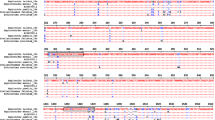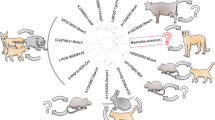Abstract
DNA primers were designed from the 18S rRNA sequence from the relevant digenean trematode Dicrocoelium dendriticum to evaluate a polymerase chain reaction-based diagnostic method of this parasite from its eggs in faeces of naturally and experimentally infected sheep. In order to get DNA from D. dendriticum eggs, several hatching mechanisms were studied. Successful results were obtained when the eggs were frozen to −80 °C and/or in liquid nitrogen and then defrosted. This method allowed the opening of the egg operculum and the liberation of the miracidium. DNA from D. dendriticum adults and from hatching egg miracidia was obtained and an amplification single band of 1.95 kb was observed using primers designed for the total 18S rRNA sequence in both cases as well as when the template DNA was from adults of the closely related parasite Fasciola hepatica; in addition, a single and specific 0.8-kb band was obtained when primers based on an internal partial 18S rRNA sequence were used. The method showed to be useful not only in samples coming from adults, but in eggs from gall bladder and faeces as well. F. hepatica internal 18S rRNA primers were also designed and used as a negative control to prove that the eggs in faeces came from D. dendriticum and not from F. hepatica. A molecular tool able to detect a minimum of about 40 D. dendriticum eggs in one of the definitive host faeces has been developed for the first time and could provide a useful molecular tool to improve the conventional coprological diagnosis for detecting D. dendriticum eggs.



Similar content being viewed by others
References
Alunda JM, Rojo-Vázquez FA (1983) Survival and infectivity of Dicrocoelium dendriticum eggs under field conditions in NW Spain. Vet Parasitol 13:245–249
Alzieu JP, Ducos de Lahitte A (1991) Dicrocoeliasis in cattle. Bull Group Tech 6(B-402):135 (in French)
Bazsalovicsová E, Králová-Hromadová I, Spakulová M, Reblánová M, Oberhauserová K (2010) Determination of ribosomal internal transcribed spacer 2 (ITS2) interspecific markers in Fasciola hepatica, Fascioloides magna, Dicrocoelium dendriticum and Paramphistomum cervi (Trematoda), parasites of wild and domestic ruminants. Helminthologia 47:76–82. doi:10.2478/s11687-010-0011-1
Boray JC (1985) Flukes of domestic animals. In: Gafaar SM, Howard WE, Marsh RE (eds) Parasites, pests and predators. Elsevier, Amsterdam, pp 179–218
Bretagne S, Guillou Morand JP, Houin R (1993) Detection of Echinococcus multilocularis DNA in fox faeces using DNA amplification. Parasitology 106:193–199
Campo R, Manga-González MY, González-Lanza C, Rollinson D, Sandoval H (1998) Characterization of adult Dicrocoelium dendriticum by isoelectric focusing. J Helminthol 72:109–116
Campo R, Manga-González MY, González-Lanza C (2000) Relationship between egg output and parasitic burden in lambs experimentally infected with different doses of Dicrocoelium dendriticum (Digenea). Vet Parasitol 87:139–149
Fagbemi BO, Obarisiagbon IO (1991) Common antigens of Fasciola gigantica, Dicrocoelium hospes and Schistosoma bovis and their relevance to serology. Vet Quarterly 13:81–87
Ferreras MC, Campo R, González-Lanza C, Pérez V, García-Marín JF, Manga-González MY (2007) Immunohistochemical study of the local immune response in lambs experimentally infected with Dicrocoelium dendriticum (Digenea). Parasitol Res 101:547–555
González-Lanza C, Manga-González MY, Campo R, Del-Pozo MP, Sandoval H, Oleaga A, Ramajo V (2000) IgG antibody response to ES or somatic antigens of Dicrocoelium dendriticum (Trematoda) in experimental infected sheep. Parasitol Res 86:472–479
Heussler V, Kaufmann H, Glaser I, Ducommun D, Müller C, Dobbelaere D (1998) A DNA probe for the detection of Dicrocoelium dendriticum in ants of Formica spp. and Lasius spp. Parasitol Res 84:505–508
Jithendran KP, Vaid J, Krishna L (1996) Comparative evaluation of agar gel precipitation, counterimmunoelectrophoresis and passive haemagglutination tests for the diagnosis of Dicrocoelium dendriticum infection in sheep and goats. Vet Parasitol 61:151–156
Johnston DA, Kane RA, Rollinson D (1993) Small subunit (18S) ribosomal RNA gene divergence in the genus Schistosoma. Parasitology 107:147–156
Kassim O, Gibertson DE (1976) Hatching of Schistosoma mansoni eggs and observations on motility of miracidia. J Parasitol 62:715–720
Manga-González MY, González-Lanza C, Cabanas E, Campo R (2001) Contributions to and review of dicrocoeliosis, with special reference to the intermediate hosts of Dicrocoelium dendriticum. Parasitology 123:S91–S114
Manga-González MY, Ferreras MC, Campo R, González-Lanza C, Pérez V, García-Marín JF (2004) Hepatic marker enzymes, biochemical parameters and pathological effects in lambs experimentally infected with Dicrocoelium dendriticum. Parasitol Res 93:344–355
Manga-González MY, González-Lanza C (2005) Field and experimental studies on Dicrocoelium dendriticum and dicrocoeliasis in northern Spain. J Helminthol 79:291–302
Manga-González MY, Quiroz-Romero H, González-Lanza C, Miñambres B, Ochoa P (2010) Strategic control of Dicrocoelium dendriticum (Digenea) egg excretion by naturally infected sheep. Veterinarni Medicina 55:19–29
Martínez-Ibeas AM, Martínez-Valladares M, González-Lanza C, Miñambres B, Manga-González MY (2011) Detection of Dicrocoelium dendriticum larval stages in mollusc and ant intermediate hosts by PCR, using mitochondrial and ribosomal internal transcribed spacer (ITS-2) sequences. Parasitology 138:1916–1923
Martínez-Pérez JM, Robles-Pérez D, Rojo-Vázquez FA, Martínez-Valladares M (2012) Comparison of three different techniques to diagnose Fasciola hepatica infection in experimentally and naturally infected sheep. Vet Parasitol 190:80–86
Maurelli MP, Rinaldi L, Capuano F, Perugini AG, Veneziano G, Cringoli G (2007) Characterization of the 28S and the second internal transcribed spacer of ribosomal DNA of Dicrocoelium dendriticum and Dicrocoelium hospes. Parasitol Res 101:1251–1255. doi:10.1007/s00436-007-0629-1
Mitterer KE (1975a) Untersuchungen zum Schlüpfen der Miracidien des Kleinen Leberegels Dicrocoelium dendriticum. Z Parasitenkd 48:35–45
Mitterer KE (1975b) Das Schlüpfen der Miracidien der Großen Leberegels Fasciola hepatica L. in Abhängigkeit verschiedener CO2-Konzentrationen. Z Parasitenkd 47:35–43
Mitterer KE (2008) Oxygen inhibits—even through in traces—the hatching of the eggs of the liver Dicrocoelium dendriticum. R Parasitol Res 102:927–929
Monnier P, Cliquet F, Aubert M, Bretagne S (1996) Improvement of a polymerase chain reaction assay of the detection of Echinococcus multilocularis DNA in faecal samples of foxes. Vet Parasitol 67:185–195
Morozova EV, Ryskov AP, Semyenova SK (2002) RAPD variation in two Trematode species (Fasciola hepatica and Dicrocoelium dendriticum) from a single cattle population. Russian J Genetics 38:977–983
Otranto D, Rehbein S, Weigl S, Castacessi C, Parisi A, Lia RP, Olson PD (2007) Morphological and molecular differentiation between Dicrocoelium dendriticum (Rudolphi, 1819) and Dicrocoelium chinensis (Sudarikov and Ryjikov, 1951) Tang and Tang, 1978 (Platyhelminthes: Digenea). Acta Trop 104:91–98. doi:10.1016/j.actatropica.2007.07.008
Ratcliffe LH (1968) Hatching of Dicrocoelium lanceolatum eggs. Exp Parasitol 23:67–78
Rojo-Vázquez FA, Cordero M, Díez P, Chaton M (1981) Relation existant entre le nombre d'oeufs dans les fèces et la charge parasitaire lors des infestations naturelles à Dicrocoelium dendriticum chez les ovins. Rev Med Vet (Toul) 132:601–607
Romia SA (1991) Length and hatchability of Schistosoma mansoni eggs. J Egypt Soc Parasitol 21:439–444
Sánchez-Andrade R, Paz-Silva A, Suarez JL, Arias M, López C, Morrondo P, Scala A (2003) Serum antibodies to Dicrocoelium dendriticum in sheep from Sardinia (Italy). Prev Vet Med 57:1–5
Sandoval H, Manga-González MY, Campo R, García P, Castro JM, Pérez de la Vega M (1999) Preliminary study on genetic variability of Dicrocoelium dendriticum determined by random amplified polymorphic DNA. Parasitol Int 48:21–26
Steindel M, Dias Neto E, de Menezes Carla LP, Romanha AJ, Simpson AJG (1993) Random amplified polymorphic DNA analysis of Trypanosoma cruzi strains. Mol Biochem Parasitol 60:71–80
Tchounwou PB, Englande AJ Jr, Malek EA, Anderson AC, Abdelghani AA (1991) The effects of ammonium sulphate and urea upon egg hatching and miracidial survival of Schistosoma mansoni. J Environ Sci Health B 26:241–257
Xu YZ, Dresden MH (1986) Leucine aminopeptidase and hatching of Schistosoma mansoni eggs. J Parasitol 72:507–511
Acknowledgments
We would like to thank Dr. R. Campo as well as C. Espiniella and M.L. Carcedo, members of the Parasitology Laboratory at the Spanish National Research Council (CSIC) in León (Spain). This work was supported by the Spanish CICYT (project no. AGF96-0416) and Castile and León Autonomy (project no. CSI5/98). H. Sandoval was supported by a Scientist Research Contract from the CSIC.
Author information
Authors and Affiliations
Corresponding author
Rights and permissions
About this article
Cite this article
Sandoval, H., Manga-González, M.Y. & Castro, J.M. A tool for diagnosis of Dicrocoelium dendriticum infection: hatching eggs and molecular identification of the miracidium. Parasitol Res 112, 1589–1595 (2013). https://doi.org/10.1007/s00436-013-3313-7
Received:
Accepted:
Published:
Issue Date:
DOI: https://doi.org/10.1007/s00436-013-3313-7




